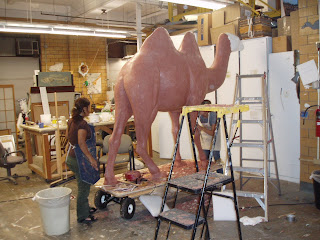This week has marked a milestone in the project. After nearly five weeks of laboring under heavy skulls of equids and their relatives, we have completed the third floor types and we are starting to rehouse the specimens in the dungeon. We may be working in paradise, but that does not mean it is smooth-water sailing. This week produced a number of "non-type" specimens impersonating types, several "stowaways" and one specimen that is so big it has to be rehoused in the cabinet drawer in lieu of in the cardboard boxes most specimens are housed in.
 This specimen includes skull, jaws, skeletal bones and fragments that all must be housed in a single drawer. With limited space in the cabinets there is no choice to split the specimen between two drawers, as we have seen with several other specimens in our time here.
This specimen includes skull, jaws, skeletal bones and fragments that all must be housed in a single drawer. With limited space in the cabinets there is no choice to split the specimen between two drawers, as we have seen with several other specimens in our time here.We have also learned about “manuscript types”, which are types that have not been published, but have been described in a manuscript. These lucky specimens were rehoused even though they are not types.
Finishing the third floor has provided a new energy throughout the group. From here we turn to the lower level (That’s the dungeon to us.) where we will be working with some different critters than the horses that will be haunting our dreams for years to come. We have broken away from the Perissodactyls and are moving on to the Artiodactyls. The lower level holds Cervidae (deer) and Moschidae (musk deer). The big cart that Carl provided for us will come in handy more now than ever as the trip to the lower level will take a significant amount of time.
Georeferencing/Element Description
With a few personal triumphs for some of the group, our progress in both Georeferencing and Element Description is coming along nicely. We are becoming more confident with each passing week, as we are grinding through the lists. Teamwork is proving to be a strong suit in this group as those who are already finished with their chunk of the lists are now helping those who had been given additional tasks.
We have had some luck tracking down some of the localities in Mongolia, which has been a thorn in our paw since the beginning of the project. We have located maps and manuscripts that help us find the localities we’re looking for.
With fingers, toes, and eyes crossed, we are hoping to be done with Element Description in the next week or two!
What is this, a school for ants?
 This week we toured through the exhibits department with Dina Langis. She showed us several different stages of the planning process for upcoming exhibits. We saw floor plans, both beginning and end process models, and full-scale pieces that are being used in the actual exhibits.
This week we toured through the exhibits department with Dina Langis. She showed us several different stages of the planning process for upcoming exhibits. We saw floor plans, both beginning and end process models, and full-scale pieces that are being used in the actual exhibits.Seeing the models was particularly interesting as it provided several perspectives and stages each exhibit goes through before being finalized and built in the gallery. Exhibits change many times from conception to the opening. There was a rough model of an upcoming exhibit about polar exploration, and a finished model of the Silk Road exhibit which is being built now.
 In the idea room, pictures, thoughts, and concepts are pinned up on bulletin boards to promote creative thinking and ideas. All along the wall were pictures for the upcoming Silk Road, Polar Exploration, and The Brain exhibits.
In the idea room, pictures, thoughts, and concepts are pinned up on bulletin boards to promote creative thinking and ideas. All along the wall were pictures for the upcoming Silk Road, Polar Exploration, and The Brain exhibits.The Silk Road exhibit, which is currently being built has some very cool pieces. A full-sized camel is being sculpted, and fake fruit now looks good enough to eat.




















 Wednesday was very similar to Tuesday. We were with Ivy and she had us practice specimen moving, label writing, and we had an introduction to the last part of box assembly which includes a shield of cloroplast. Her motto echoed throughout the day, "as tall as necessary as small as possible." We then used trirod, a close relative of ethafoam, to sculpt around a specimen in order to create a secure environment for the specimens so that it may pass the wiggle test. . The day ended with us pulling and picking out our first specimens for the rehousing project.
Wednesday was very similar to Tuesday. We were with Ivy and she had us practice specimen moving, label writing, and we had an introduction to the last part of box assembly which includes a shield of cloroplast. Her motto echoed throughout the day, "as tall as necessary as small as possible." We then used trirod, a close relative of ethafoam, to sculpt around a specimen in order to create a secure environment for the specimens so that it may pass the wiggle test. . The day ended with us pulling and picking out our first specimens for the rehousing project. 